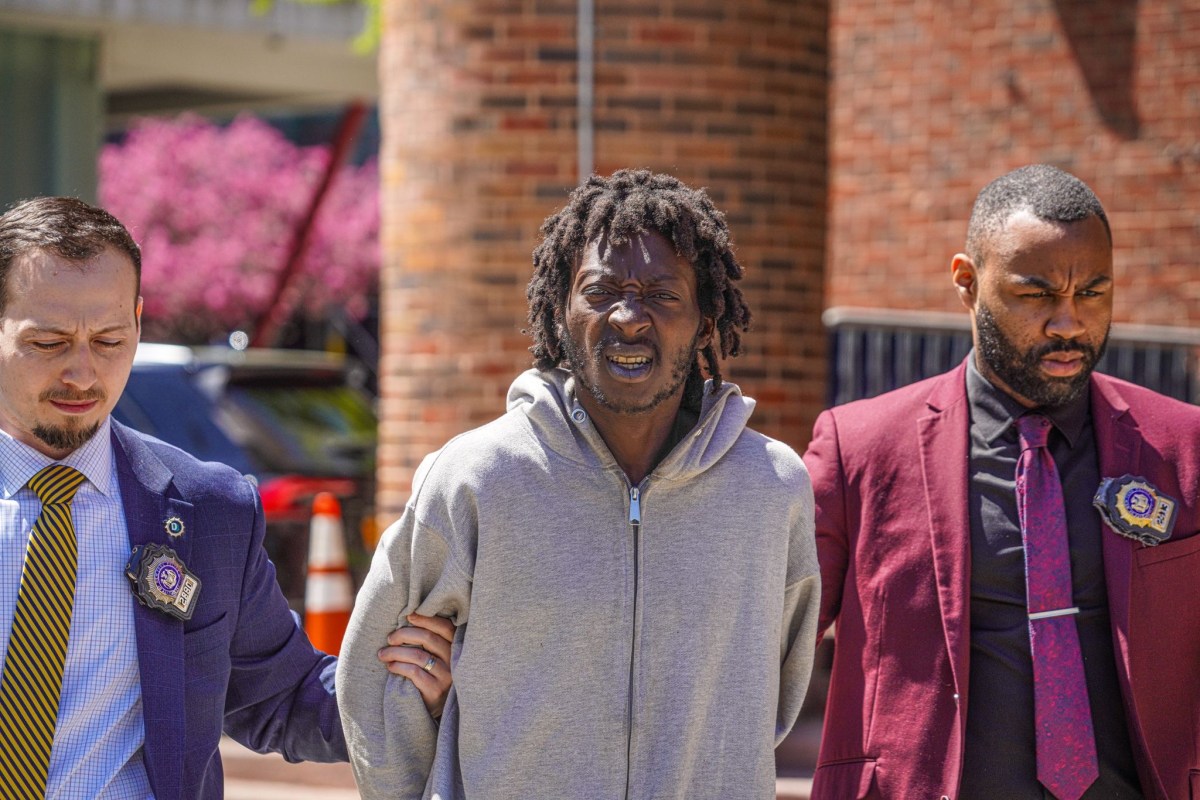 Leonardo Cimino tends to Kenneth McMillan’s acne problem in David Lynch’s “Dune.”
Leonardo Cimino tends to Kenneth McMillan’s acne problem in David Lynch’s “Dune.”
Newly out in theaters is the documentary “Jodorowsky’s Dune,” about “El Topo” legend Alejandro Jodorowky’s scuttled attempt to make a gargantuan, trippy film of Frank Herbert’s novel. It was supposed to change everything. Instead, “Star Wars” did — although, the doc argues, pieces of it wound up scattering about the culture anyway, in “Alien,” “Blade Runner,” “Flash Gordon,” “Contact,” even the sad 1987 He-Man movie “Masters of the Universe.”
Inevitably focus has turned to the “Dune” that did get made, namely David Lynch’s 1984 disaster, which is roundly considered the runt of the filmmaker’s litter and generally viewed as unclean. That opinion isn’t unwarranted. But the film is not that bad. “Not that bad” may not set hearts aflutter, but Lynch’s deeply, deeply flawed “Dune” — which he himself, to this day, refuses to speak about, given that it nearly destroyed his career in its infancy — is one of the craziest films to ever play mainstream movie theaters: a collision of an impossible-to-condense source and a filmmaker inextricably drawn to the profoundly disturbing (unless he’s making nice, G-rated movies about old-timers riding lawnmowers).
It’s hard to remember just how big this film was SUPPOSED to be. It was supposed to be the new “Star Wars,” and presumably launch films on the other “Dune” novels. (Herbert died in 1986, one year after the release of the sixth entry, “Chapterhouse: Dune.”) Indeed, Lynch took the “Dune” job after turning down “Return of the Jedi.” (The ‘80s were weird.) There was a line of action figures, which means some poor kids had to play with little Kyle MacLachlans. There were Topps Trading Cards, storybooks and coloring books.
The backlash was inevitable. Roger Ebert called it the worst film of the year, and others were only slightly more impressed. There’s a lot that’s obvious wrongly with it. For one, it’s a gruesome trash compactor version of one of sci-fi’s most dense masterworks. It takes a full half-hour of false starts to even get to the main plot. That includes such tactics as having Virginia Madsen’s disembodied head floating in space, vomiting up exposition. (This same method was presumably borrowed by the another notorious sci-fi beast, “Zardoz,” the (actually terrific) 1973 sci-fi with Sean Connery in a loincloth, whose attempt to introduce a strange world to a mainstream audience also ends in confusion.)
The first half is relatively coherent and faithful to the novel. But once the house of noble Duke Leto Atreides (Jurgen Prochnow) has been felled by evil floating fattie Baron Harkonen (Kenneth McMillan), only an hour remains to tell of the former’s vengeful son, Paul (MacLachlan), and his ascent to becoming a Messiah-like leader to a fallen people. That means endless montages and narration that rushes us into a not-bad knife-fight climax between Paul and sadistic Harkonen son, Feyd (Sting!).
Obviously it needed to be several hours long, or even multiple movies. (There’s a three-hour TV cut that makes more sense, but Lynch had nothing to do with it — because he wants nothing to do with “Dune” ever — and it’s attributed to the once prevalent but now disused directorial pseudonym “Alan Smithee.”) The most snicker-inducing ploy to convey exposition — in a film that is already 90% people standing around explaining the plot to eachother — is to put characters’ thoughts on the soundtrack in whispers, while the actors stand there making awkward thinking faces.
OK, so what’s good about it? First off, it actually commits to being a “Dune” movie. It doesn’t try to make it “Star Wars,” even with the occasional battle and, in the second half, massive sandworm-riding. Even with the expected Joseph Campbell zero-to-hero plot trajectory, it’s for nerds. In fact, since the storytelling is so garbled, only nerds will likely be able to follow it, in part because they can fill in the often gaping narrative holes with their memory of the novel. (When it came out, viewers were handed out papers with a glossary of terms, which they were to quickly memorize lest they be lost in the first few minutes.)
Much, much more important, though, is the imagery. This is usually considered the least Lynchian of David Lynch’s movies. This is untrue. It’s more Lynch than is comfortable. He gets lost in the storytelling — he wrote the script himself, which was probably foolish — but he absolutely brings his yen for disturbing, nightmarish visuals. This starts off almost immediately: The second scene depicts the mysterious “Guild Navigator,” a brainiac character Lynch devises as a literal giant talking brain floating in a tank of brine. His mouth is triangular-shaped. There’s really no clean way of saying this, so here goes: It looks like a vagina. And it secretes gas. Lynch likes to shoot this in graphic close-up, and they’re explicit enough that if you see the film cut on TV, the editors completely omit these shots.
Look, teenagers saw this in MALLS. They took dates to this. (They did not get laid.) Noting that the film cost a reported $60 million, critic Dave Kehr charged that, “producer Dino De Laurentiis must be the greatest patron of avant-garde cinema since the Vicomte de Noailles financed [Luis] Bunuel’s ‘L’Age d’Or.’” Indeed, everything, from the S&M costumes to the tube-heavy sets, scream sex and transgression. The film peaks early, with a scene that hangs with the evil Harkonens, as the Baron has what looks like an extreme acne problem worked on by a lecherous doctor, who talks lovingly about his “diseases.” One of his sons makes a drink that involves squishing a live insect-of-sorts then sucking down the juices. It ends with the Baron floating around and — in a fit of homophobia typical of the era — raping and killing a boy. (Again, this played in MALLS — and like the Guild Navigator scene, much of this was too hot for TV cuts.)
Turn off the sound — and your brain — and Lynch’s “Dune” is a hotbed of freaky imagery. (Although turn off the sound and you’ll miss Toto’s actually not bad, sometimes even stirring score, with assists from no less than Brian Eno.) Only partly paying attention can sometimes be for the best: the acting, for one, is very spotty, with some (MacLachlan, Prochnow, even Dean Stockwell) wooden, others (McMillan, Brad Douriff, Silvana Mangano) enjoyably hammy. Still, it does, even in its two-hour-and-change theatrical cut, get the story done, however at times confusingly. It’s the right kind of disaster — a very personal vision accidentally funded by wealthy donors. It was bound to end in failure. And like many failures, it can only have aged well. After all, it had nowhere to go but up.
Follow Matt Prigge on Twitter @mattprigge
















